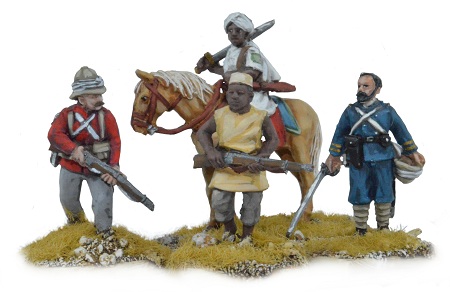Larry V. Brom’s classic colonel war-gaming rules written in 1979 are currently my preferred system for battles in this period. In stark contrast to most modern rule books (which are chocka with eye candy), my 20th Anniversary edition (1999) is printed entirely in black and white and devoid of any photos of figures. Nevertheless, this is a great set of rules (IMO) and I have had many enjoyable games using these rules. On this page, I will cover in brief some of what attracts me to the Sword and the Flame. Please bare in mind the following is not intended to be a review or sales pitch of any kind, it is merely some basic info on the rule mechanics and why I like them.
The main forces covered by rules
- British- Infantry, cavalry ,Artillery and machine guns.
- Pathan- Infantry (rifles/Jezails and sword units),artillery and horse.
- Zulus- Rifles and spear units
- Boers- Foot, horse and artillery.
- Egyptians- Infantry, cavalry, Artillery and machine guns.
- Dervishes- Spears, swords, rifles, artillery, horse and camels.

Game size and scale.
All figures are individually based. Infantry units (platoons) are 20 figures strong, cavalry troops require 12 figures, while 4 figures with a gun constitutes an artillery piece. Each British and Egyptian infantry platoon has a NCO and lieutenant, both of which effect morale rolls throughout the game. Two platoons make up a company with a Captain and Sergeant major attached. Cavalry and artillery follow a similar formula to the infantry when adding extra units.
Zulus, Pathan, Dervish and Boers only receive one leader per unit and one extra commander per three units.
There is a points system included in the book but I tend to use the ratios provided in the troop organization section ( eg. 2.25 Dervish units to every 1 British unit). In general, I find that 4-5 British units with the relative number of Dervish on a 5ft by 6ft table makes for a good size game using 25mm figures.
Sequence of Play
- Movement- Is card activated, with dice generated random movement distances.
- Shooting- Again card activated and D20 based. There is limited ammo and rules which cover the fate of any wounded that fall into the hands of a merciless enemy. This has a detrimental effect on imperial morale (so leave no man behind).
- Close combat- Is pretty standard stuff really, opposing dice rolls with modifiers.
- Morale- It should be said that there is a lot of testing in this game, test to charge, stand, rally when shaken or to move when leaderless and so on.
What appeals to me in this system.
Formation rules– Open order allows better shooting, but leaves your men vulnerable when charged. Where as placing your infantry into square gives great hand to hand bonuses, but squares suffer terribly when under fire.
Variable movement-This eliminates all that pre-measuring malarkey and adds a great deal of uncertainty into the game (the fog of war). Jokers, when drawn from the deck of cards give an extra move to the corresponding side. This can allow some units to suddenly become very dangerous.
A couple of other movement rules that appeal to me, are testing for stragglers when charging and the hidden deployment rules for natives. Both of which make for a very entertaining game.
Random ammo generation and independent fire– Each side generates their total ammo allowance in secret at the beginning of the game. Thus if your opponents fire starts to slacken it could mean he is low or out of ammo. Is it time to risk that final do or die charge across open ground? Independent fire is potentially more devastating than volley fire, but it burns through your precious ammo reserve a lot quicker.
Summary To me this is a game where you look for or try to make opportunities to do things rather that take every opportunity to do something. For example; blaze away in every shooting phase with every gun you have will soon deplete your limited ammo supply, far better to wait until you can see the whites of their eyes so to speak.


Morale testing
As I have already stated above, morale tests are required to complete a lot of unit actions, so it is important for your leaders to stay alive as long as possible. With the morale tests being such an important part of the game I decided to create a flow chart as a kind of QRS on when to test for what, before and after combat. This is not that these tests are overly tricky, it’s mainly because I usually only manage to play one or two colonial games a year and this is the quickest way (for me) to get back up to speed on this section of the rules.

Reference material
I found the following books contained a great deal of useful information on both the troops and battles from these campaigns.
The Mahdist Wars Source Book volumes one and two. Although printed mainly in black and white, volume one does contain a few colour plates depicting flags and uniforms. Both volumes are packed with a lot of great (savage soldier) articles on everything from, troop types, uniforms, flags, battles and campaigns. Volume one covers the period from 1883-1885, while volume two covers from 1885-1899.
Go Strong Into the Desert. This beautifully illustrated book covers the Mahdist uprising from 1881-1885. It contains some great uniform plates and battle field photos.



